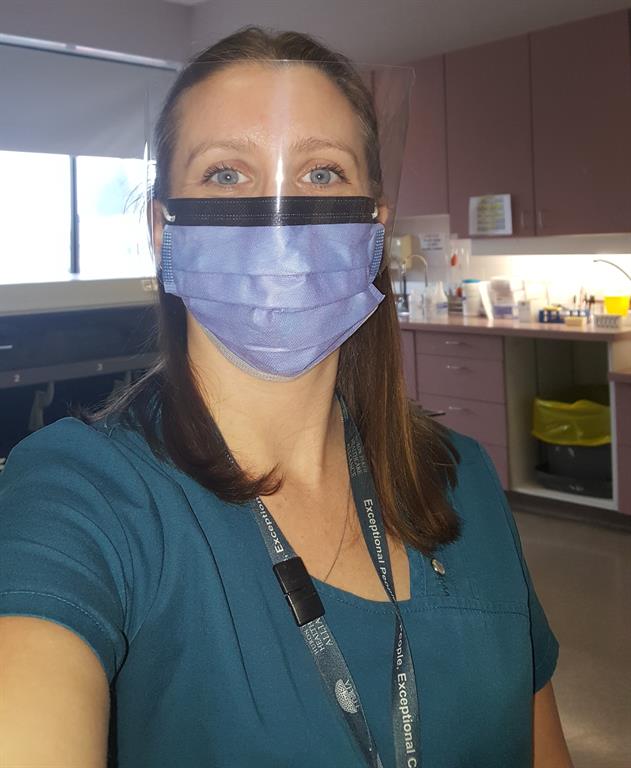Take a Closer Look: Lab
April 12, 2021
Medical laboratory professionals are an essential part of the health care team. These dedicated heroes work around the clock, and although they may often be behind the scenes, the work they do directly impacts patient care.
April 11 to 17 is National Medical Laboratory Week and to celebrate, let’s take a closer look at the important roles and functions of HPHA’s Laboratories!
Types of Lab Professionals Working at HPHA!
Medical Laboratory Assistants/Technicians (MLA/Ts) - MLA/Ts have many important roles. They collect samples directly from patients and then sort, prepare and process samples which are analyzed by Medical Laboratory Technologists. At HPHA, we have many MLAs who work to the full scope of practice running patient samples, maintaining complicated instruments, ordering and stocking supplies and communicating with nurses and physicians and other members of the health care team.

Above: Adrienne, MLA/TMedical Laboratory Technologists (MLT) - MLTs are regulated health care professionals. They analyze tissue samples, blood and body fluids. The high quality results they provide help physicians diagnose, treat and care for patients.

Above: Tim, MLT
Pathologist Assistants (PAs) - PAs work with pathologists to examine surgical specimens, identify anatomical components and dissect tissue for further investigation.
Laboratory Transcriptionists - Laboratory transcriptionists transcribe dictations by PAs and pathologists, answer and direct phone calls, liaise with other organizations, refer specimens out for further investigation, file important documents and deliver specimens.

Above: Cindy, Transcriptionist
Behind the Scenes: Microbiology, Core Lab & Histopathology
Microbiology
The Microbiology department is where blood, body fluid and/or tissue samples are sent to detect bacteria, fungi, viruses and/or parasites.
A typical day begins with taking a look at the blood culture incubator to see if any bottles have turned positive. These are then set up on plates by MLA/Ts and gram stains are read and reported by MLTs. Machines are turned on and maintained. Each bench reads any previous plates that have been incubating, determining if further testing needs to be set up or performed such as identification or antibiotic susceptibility testing. New plates are then looked at and assessed for further testing as well. Fluids are analyzed, PCR testing is performed, phone calls are answered. Every day is busy but the staff in microbiology always deliver accurate results of the highest quality.

Above: L to R: Patti, MLT; Chantel, MLA/T; Sarah MLA/T and Bev, MLT
Core Laboratory
The Core Laboratory consists of clinical chemistry, where blood, urine and other body fluids are tested to detect chemicals, hormones or drugs; hematology (detection of disorders or diseases of the blood, coagulation tests); and transfusion science (blood typing and compatibility tests).
Days in the Core Lab generally start with MLA/Ts or MLTs (depending on which HPHA site) doing blood collection on the inpatient units. As samples come in from all areas of the hospital, they are received and sorted and sent on their way. MLTs and MLA/Ts are busy in the laboratory getting analyzers up and running, making sure that quality controls are within their expected ranges to ensure the best possible quality of results. Samples are then run on the analyzers, results carefully scrutinized for any critical values that must be communicated to nursing or physicians or samples that require further investigation (i.e. blood smear). Inventory of blood products is also taken and any upcoming transfusions are assessed, MLTs performing type and screens and cross matches on patients to know which unit of blood to give.
Such complicated equipment requires regular maintenance, which is performed by MLA/Ts and MLTs every day to make sure that they are kept in working order. Sometimes something stops working and it is then up to the laboratory staff to troubleshoot and repair issues with the help of technical support.

Above: L to R: Maham, MLT & Kylen, MLT
Histopathology
Histopathology includes the microscopic identification and study of diseased tissue. MLA/Ts, MLTs, Transcriptionists and PAs all work within the department, and the final product of tissue slides are observed by Pathologists.
Samples received in this department flow through a set process with multiple steps. Samples undergo fixation and are then grossed (dissected) by a PA. Then they go through processing during which they are infiltrated with wax. Samples are then embedded in paraffin wax to support the tissue and to allow the cutting of thin slices using a specialized precision cutting instrument called a microtome. These slices are then placed on a glass slide, stained in order to highlight features of interest for viewing by a Pathologist. Additional specialized staining can then occur to assist the Pathologist with an accurate diagnosis.